Controls of Submarine Canyons Connected to Shore during the LGM Sea-Level Rise: Examples from Taiwan
Abstract
:1. Introduction
2. Geological Setting
2.1. SW Taiwan Margin
2.2. NE Taiwan Margin
2.3. East Taiwan Margin
3. Data and Methods
4. Results
4.1. SW Taiwan Margin
4.2. NE Taiwan Margin
4.3. East Taiwan Margin
5. Discussion
5.1. Types and Occurrences of Submarine Canyons off the Shore of Taiwan
5.2. Controls of Submarine Canyons Connected to the Shore
5.3. Development of Submarine Canyons off Taiwan Margin since the LGM
6. Conclusions
Author Contributions
Funding
Institutional Review Board Statement
Informed Consent Statement
Data Availability Statement
Acknowledgments
Conflicts of Interest
References
- Walsh, J.P.; Alexander, C.R.; Gerber, T.; Orpin, A.R.; Sumners, B.W. Demise of a submarine canyon? Evidence for highstand infilling on the Waipaoa River continental margin, New Zealand. Geophys. Res. Lett. 2007, 34, L20606. [Google Scholar] [CrossRef]
- Posamentier, H.; Erskine, R.; Mitchum, R., Jr. Models for Submarine-fan deposition within a sequence stratigraphic framework. In Seismic Facies and Sedimentary Process of Submarine Fans and Turbidite Systems; Springer: New York, NY, USA, 1991. [Google Scholar]
- Covault, J.A.; Graham, S.A. Submarine fans at all sea-level stands: Tectono-morphologic and climatic controls on terrigenous sediment delivery to the deep sea. Geology 2010, 38, 939–942. [Google Scholar] [CrossRef]
- Bernhardt, A.; Melnick, D.; Jara-Muñoz, J.; Argandoña, B.; González, J.; Strecker, M.R. Controls on submarine canyon activity during sea-level highstands: The Biobío canyon system offshore Chile. Geosphere 2015, 11, 1226–1255. [Google Scholar] [CrossRef] [Green Version]
- Chiocci, F.L.; Casalbore, D. Unexpected fast rate of morphological evolution of geologically-active continental margins during Quaternary: Examples from selected areas in the Italian seas. Mar. Pet. Geol. 2017, 82, 154–162. [Google Scholar] [CrossRef]
- Pierdomenico, M.; Casalbore, D.; Chiocci, F.L. The key role of canyons in funnelling litter to the deep sea: A study of the Gioia Canyon (Southern TyrrhenianSea). Anthropocene 2020, 30, 100237. [Google Scholar] [CrossRef]
- Casalbore, D.; Biancone, M.; Casas, D.; Mata, P.; Alonso, B.; Ercilla, G.; Chiocci, F.L.; Bárcenas, P.; López-González, N. Holocene morpho-stratigraphic evolution of a compound submarine deltaic system in front of the shelf-incising Almanzora and Garrucha Canyons (Palomares margin, southeastern Iberia). Mar. Geol. 2022, 444, 106708. [Google Scholar] [CrossRef]
- Babonneau, N.; Savoye, B.; Cremer, M.; Klein, B. Morphology and architecture of the present canyon and channel system of the Zaire deep-sea fan. Mar. Pet. Geol. 2002, 19, 445–467. [Google Scholar] [CrossRef]
- Khripounoff, A.; Vangriesheim, A.; Babonneau, N.; Crassous, P.; Dennielou, B.; Savoye, B. Direct observation of intense turbidity current activity in the Zaire submarine valley at 4000 m water depth. Mar. Geol. 2003, 194, 151–158. [Google Scholar] [CrossRef] [Green Version]
- Khripounoff, A.; Vangriesheim, A.; Crassous, P.; Etoubleau, J. High frequency of sediment gravity flow events in the Var submarine canyon (Mediterranean Sea). Mar. Geol. 2009, 263, 1–6. [Google Scholar] [CrossRef] [Green Version]
- Casalbore, D.; Chiocci, F.L.; Mugnozza, G.S.; Tommasi, P.; Sposato, A. Flash-food hyperpycnal flows generating shallow-water landslides at Fiumara mouths in Western Messina Strait (Italy). Mar. Geophys. Res. 2011, 32, 257–271. [Google Scholar] [CrossRef]
- Pierdomenico, M.; Casalbore, D.; Chiocci, F.L. Massive benthic litter funnelled to deep sea by flash-flood generated hyperpycnal flows. Sci. Rep. 2019, 9, 5330. [Google Scholar] [CrossRef] [PubMed] [Green Version]
- Liu, J.T.; Liu, K.J.; Huang, J.C. The effect of a submarine canyon on the river sediment dispersal and inner shelf sediment movements in southern Taiwan. Mar. Geol. 2002, 181, 357–386. [Google Scholar] [CrossRef]
- Yu, H.S.; Chiang, C.S.; Shen, S.M. Tectonically active sediment dispersal system in SW Taiwan margin with emphasis on the Gaoping (Kaoping) Submarine Canyon. J. Mar. Syst. 2009, 76, 369–382. [Google Scholar] [CrossRef]
- Chiang, C.S.; Hsiung, K.H.; Yu, Y.S.; Chen, S.C. Three types of modern submarine canyons on the tectonically active continental margin offshore southwestern Taiwan. Mar. Geophy. Res. 2020, 41, 4. [Google Scholar] [CrossRef]
- Chiang, C.S.; Yu, H.S. Morphological Significance and Relation of Ecosystems of Submarine Canyons off SW Taiwan. J. Mar. Sci. Eng. 2021, 9, 1296. [Google Scholar] [CrossRef]
- Covault, J.A.; Normark, W.R.; Romans, B.W.; Graham, S.A. Highstand fans in the California borderland: The overlooked deep-water depositional system. Geology 2007, 35, 783–786. [Google Scholar] [CrossRef] [Green Version]
- Hung, J.J.; Lin, C.S.; Chung, Y.C.; Hung, G.W.; Liu, W.S. Lateral fluxes of biogenic particles through the Mien-Hua canyon in the Southern East China Sea Slope. Cont. Shelf Res. 2003, 23, 935–955. [Google Scholar] [CrossRef]
- Hsu, S.C.; Lin, F.J.; Jeng, W.L.; Chung, Y.C.; Shaw, L.M.; Hung, K.W. Observed Sediment Fluxes in the Southwesternmost Okinawa Trough enhanced by episodic events: Flood runoff from Taiwan rivers and large earthquakes. Deep Sea Res. Oceanogr. Res. Pap. 2004, 51, 979–997. [Google Scholar] [CrossRef]
- Chiang, C.S.; Yu, H.S.; Noda, A.; TuZino, T. The Huapinghsu Channel/Mienhua Canyon System as a Sediment Conduit Transporting Sediments from Offshore North Taiwan to the Southern Okinawa Trough. Front. Earth Sci. 2022, 9, 792595. [Google Scholar] [CrossRef]
- Bernhardt, A.; Schwanghart, W. Where and why do submarine canyons remain connected to the shore during sea-level rise? Insights from global topographic analysis and Bayesian regression. Geophys. Res. Lett. 2021, 48, e2020GL092234. [Google Scholar] [CrossRef]
- Harris, P.T.; Whiteway, T. Global distribution of large submarine canyons: Geomorphic differences between active and passive continental margins. Mar. Geol. 2011, 285, 69–86. [Google Scholar] [CrossRef]
- Suppe, J. Kinematics of arc-continent collision, flipping of subduction, and back-arc spreading near Taiwan. Mem. Geol. Soc. China 1984, 6, 21–33. [Google Scholar]
- Covey, M. Lithofacies analysis and basin reconstruction, Plio-Pleistocene western Taiwan foredeep. Petrol. Geol. Taiwan 1984, 20, 53–83. [Google Scholar]
- Yu, H.S.; Chou, Y.W. Characteristics and development of the flexural forebulge and basal unconformity of Western Taiwan Foreland Basin. Tectonophysics 2001, 333, 277–291. [Google Scholar] [CrossRef]
- Chiang, C.S.; Yu, H.S.; Chou, Y.W. Characteristics of the wedge-top depozone of the southern Taiwan foreland basin system. Basin Res. 2004, 16, 65–78. [Google Scholar] [CrossRef]
- Dadson, S.J.; Hovious, N.; Chen, H.; Dade, W.B.; Hsieh, M.L.; Willett, S.D.; Hu, J.C.; Horng, M.J.; Chen, M.C.; Stark, C.P.; et al. Links between erosion, runoff variability and seismicity in the Taiwan orogen. Nature 2003, 426, 648–651. [Google Scholar] [CrossRef]
- Mulder, T.; Syvitski, J.P.M. Turbidity Currents Generated at River Mouths during Exceptional Discharges to the World Oceans. J. Geol. 1995, 103, 285–299. [Google Scholar] [CrossRef]
- Dadson, S.; Hovius, N.; Pegg, S.; Dade, W.B.; Horng, M.J.; Chen, H. Hyperpycnal river flows from an active mountain belt. J. Geophys. Res. 2005, 110, F04016. [Google Scholar] [CrossRef]
- Chiang, C.S.; Yu, H.S. Morphotectonics and incision of the Kaoping submarine canyon, SW Taiwan orogenic wedge. Geomorphology 2006, 80, 199–213. [Google Scholar] [CrossRef]
- Lin, A.T.; Yao, B.; Hsu, S.K.; Liu, C.S.; Huang, C.Y. Tectonic features of the incipient arc-continent collision zone of Taiwan: Implications for seismicity. Tectonophysics 2009, 479, 28–42. [Google Scholar] [CrossRef]
- Chen, S.C.; Hsu, S.K.; Wang, Y.S.; Chung, S.H.; Chen, P.C.; Tsai, C.H.; Liu, C.S.; Lin, H.S.; Lee, Y.W. Distribution and characters of the mud diapirs and mud volcanoes off southwest Taiwan. J. Asian Earth Sci. 2014, 92, 201–214. [Google Scholar] [CrossRef]
- Yu, H.S.; Hong, E. The Huapinghsu channel/canyon system off northeastern Taiwan: Morphology, sediment character and origin. Terr. Atmos. Ocean Sci. 1993, 4, 307–319. [Google Scholar] [CrossRef]
- Song, G.S.; Ma, C.P.; Yu, H.S. Fault genesis of the Chilung Sea Valley revealed by topographic lineaments. Mar. Geol. 2000, 169, 305–325. [Google Scholar] [CrossRef]
- Tsai, C.H.; Huang, C.L.; Hsu, S.K.; Doo, W.B.; Lin, S.S.; Wang, S.Y.; Lin, J.Y.; Liang, C.W. Active normal faults and submarine landslides in the Keelung Shelf off NE Taiwan. Terr. Atmos. Ocean Sci. 2018, 29, 31–38. [Google Scholar] [CrossRef] [Green Version]
- Hsieh, Y.H.; Liu, C.S.; Suppe, J.; Byrne, T.B.; Lallemand, S. The Chimei submarine canyon and fan: A record of Taiwan arc-continent collision on the rapidly deforming over-riding plate. Tectonics 2020, 39, e2020TC006148. [Google Scholar] [CrossRef]
- Lehu, R.; Lallemand, S.; Hsu, S.K.; Babonneau, N.; Ratzov, G.; Lin, A.T.; Dezileau, L. Deep-sea sedimentation offshore eastern Taiwan: Facies and processes characterization. Mar. Geol. 2015, 369, 1–18. [Google Scholar] [CrossRef]
- Hsu, H.H.; Liu, C.S.; Chen, T.T.; Hung, H.T. Stratigraphic framework and sediment wave fields associated with canyon-levee systems in the Huatung Basin offshore Taiwan Orogen. Mar. Geol. 2021, 433, 106408. [Google Scholar] [CrossRef]
- Hsiung, K.H.; Kanamatsu, T.; Ikehara, K.; Shiraishi, K.; Horng, C.S.; Usami, K. Morpho-sedimentary features and sediment dispersal systems of the southwest end of Ryukyu Trench: A source-to-sink approach. Geo. Mar. Lett. 2017, 37, 561–577. [Google Scholar] [CrossRef]
- Yu, H.S.; Lee, M.L. Morphological and seismic characteristics of the North Mienhua submarine canyon off northeastern Taiwan. Terr. Atmos. Ocean Sci. 1998, 9, 263–278. [Google Scholar] [CrossRef]
- Chen, W.S.; Yang, C.Y.; Chen, S.T.; Huang, Y.C. New insights into Holocene marine terrace development caused by seismic and aseismic faulting in the Coastal Range, eastern Taiwan. Quat. Sci. Rev. 2020, 240, 106369. [Google Scholar] [CrossRef]
- Zazo, C.; Goy, J.L.; Dabrio, C.J.; Bardaji, T.; Hillaire-Marcel, C.; Ghaleb, B.; Soler, V. Pleistocene raised marine terraces of the Spanish Mediterranean and Atlantic coasts: Records of coastal uplift, sea-level highstands and climate changes. Mar. Geol. 2003, 194, 103–133. [Google Scholar] [CrossRef] [Green Version]
- Hsu, S.K.; Kuo, J.; Lo, C.L.; Tsai, C.H.; Doo, W.B.; Ku, C.Y.; Sibuet, J.C. Turbidity currents, submarine landslides and the 2006 Pingtung earthquake off SW Taiwan. Terr. Atmos. Ocean Sci. 2008, 19, 767–772. [Google Scholar] [CrossRef] [Green Version]
- Gavey, R.; Carter, L.; Liu, J.T.; Talling, P.J.; Hsu, R.; Pope, E.; Evans, G. Frequent sediment density flows during 2006 to 2015, triggered by competing seismic and weather events: Observations from subsea cable breaks off southern Taiwan. Mar. Geol. 2017, 384, 147–158. [Google Scholar] [CrossRef]
- Ikehara, K.; Usami, K.; Kanamatsu, T. Repeated occurrence of surface-sediment remobilization along the landward slope of the Japan Trench by great earthquakes. Earth Planets Space 2020, 72, 114. [Google Scholar] [CrossRef]
- Huh, C.A.; Lin, H.L.; Lin, S.; Huang, Y.W. Modern accumulation rates and a budget of sediment off the Gaoping (Kaoping) River, SW Taiwan: A tidal and flood dominated depositional environment around a submarine canyon. J. Mar. Syst. 2009, 76, 405–416. [Google Scholar] [CrossRef]
- Popescu, I.; Panin, N.; Jipa, D.; Lericolais, G.; Ion, G. Submarine canyons of the Black Sea basin with a focus on the Danube canyon. CIESM Monogr. 2015, 47, 103–121. [Google Scholar]
- Jipa, D.C.; Panin, N. Narrow shelf canyons vs. wide shelf canyons: Two distinct types of Black Sea submarine canyons. Quat. Int. 2018, 540, 120–136. [Google Scholar] [CrossRef]
- Huh, C.A.; Su, C.C.; Liang, W.T.; Ling, C.Y. Linkages between Turbidites in the Southern Okinawa Trough and Submarine Earthquakes. Geophys. Res. Lett. 2004, 31, L12304. [Google Scholar] [CrossRef]
- Mountjoy, J.J.; Howarth, J.D.; Orpin, A.R.; Barnes, P.M.; Bowden, D.A.; Rowden, A.A.; Schimel, A.C.; Holden, C.; Horgan, H.J.; Nodder, S.D. Earthquakes drive largescale submarine canyon development and sediment supply to deep-ocean basins. Sci. Adv. 2018, 4, eaar3748. [Google Scholar] [CrossRef] [Green Version]
- Chiang, C.S.; Yu, H.S. Evidence of hyperpycnal flows at the head of the meandering Kaoping Canyon off SW Taiwan. Geo-Mar. Lett. 2008, 28, 161–169. [Google Scholar] [CrossRef]
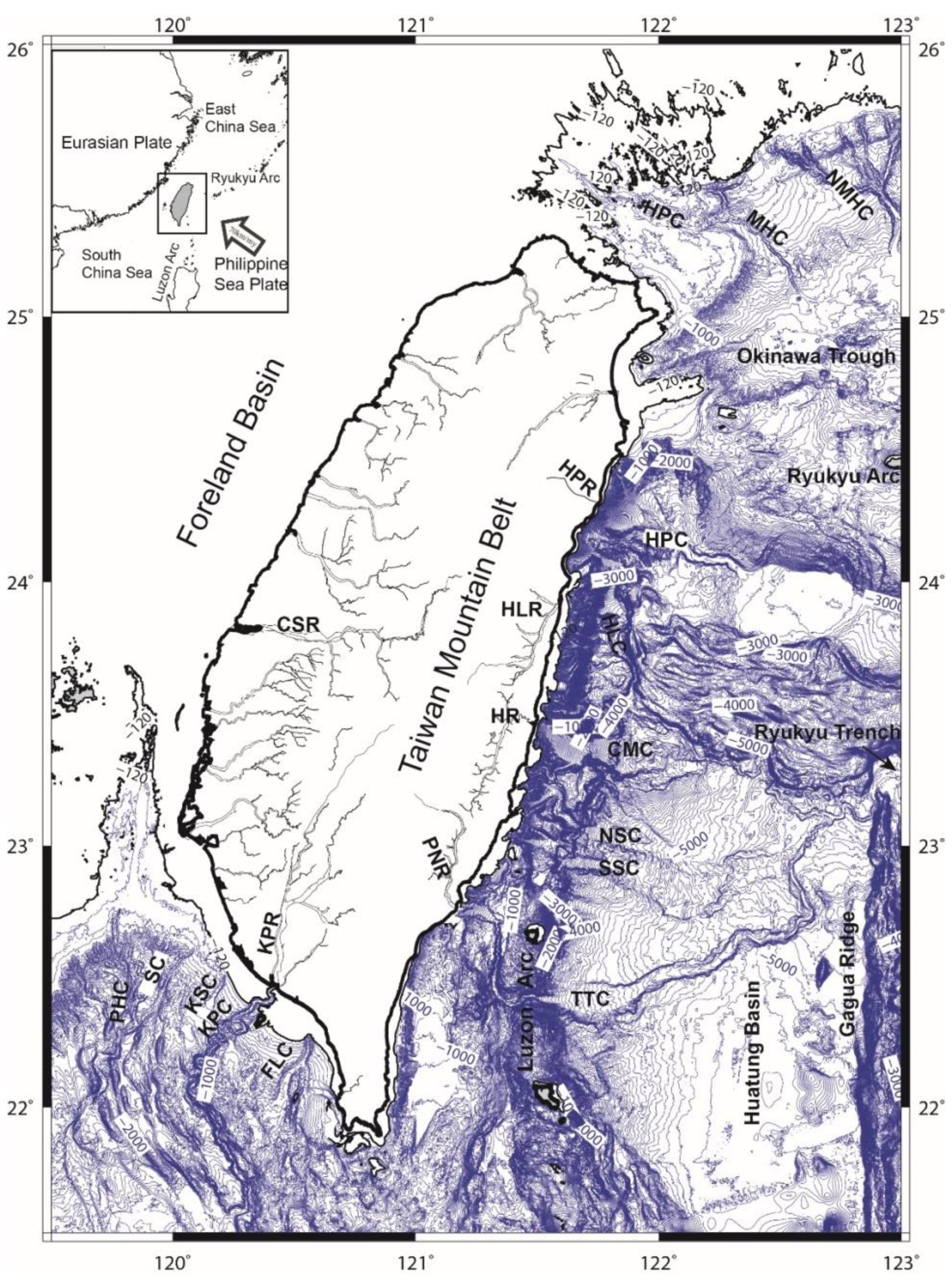
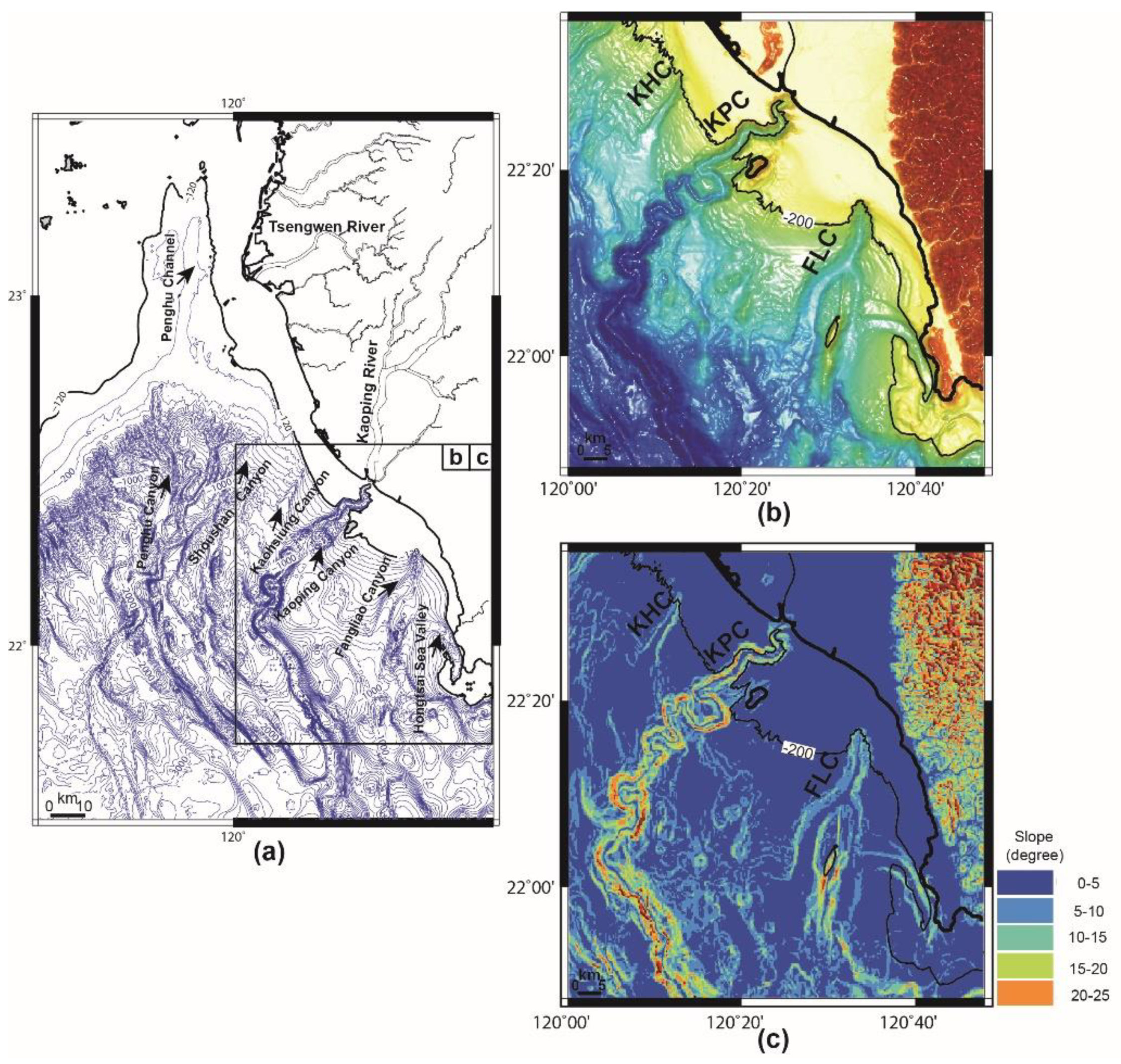
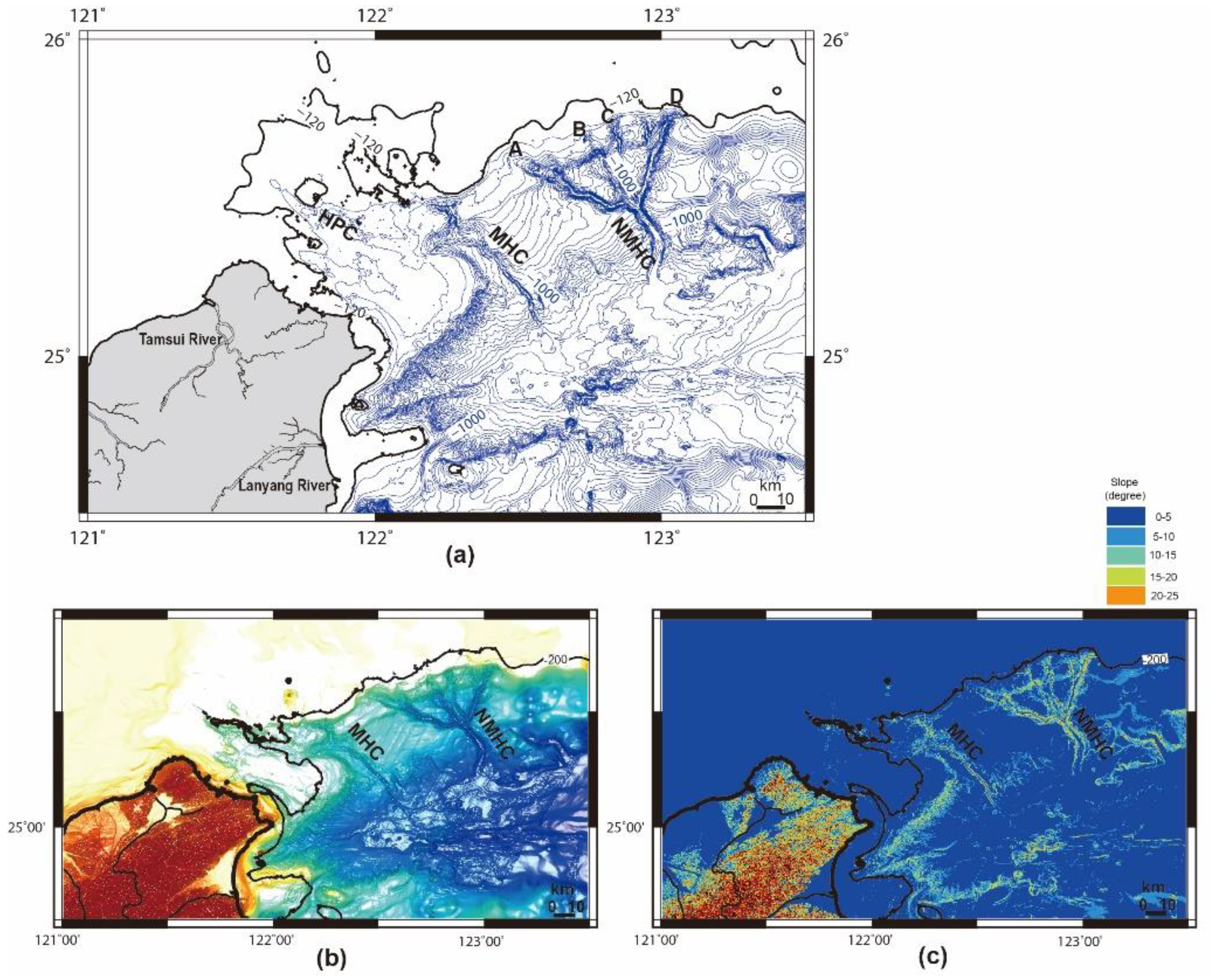
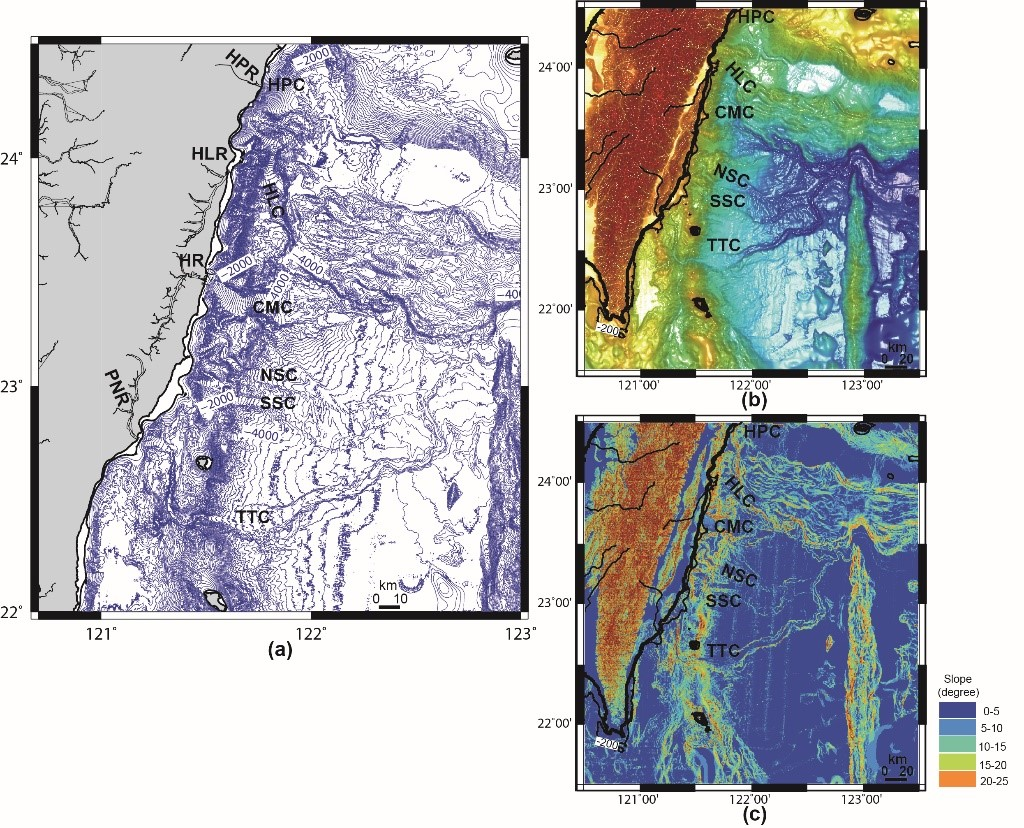
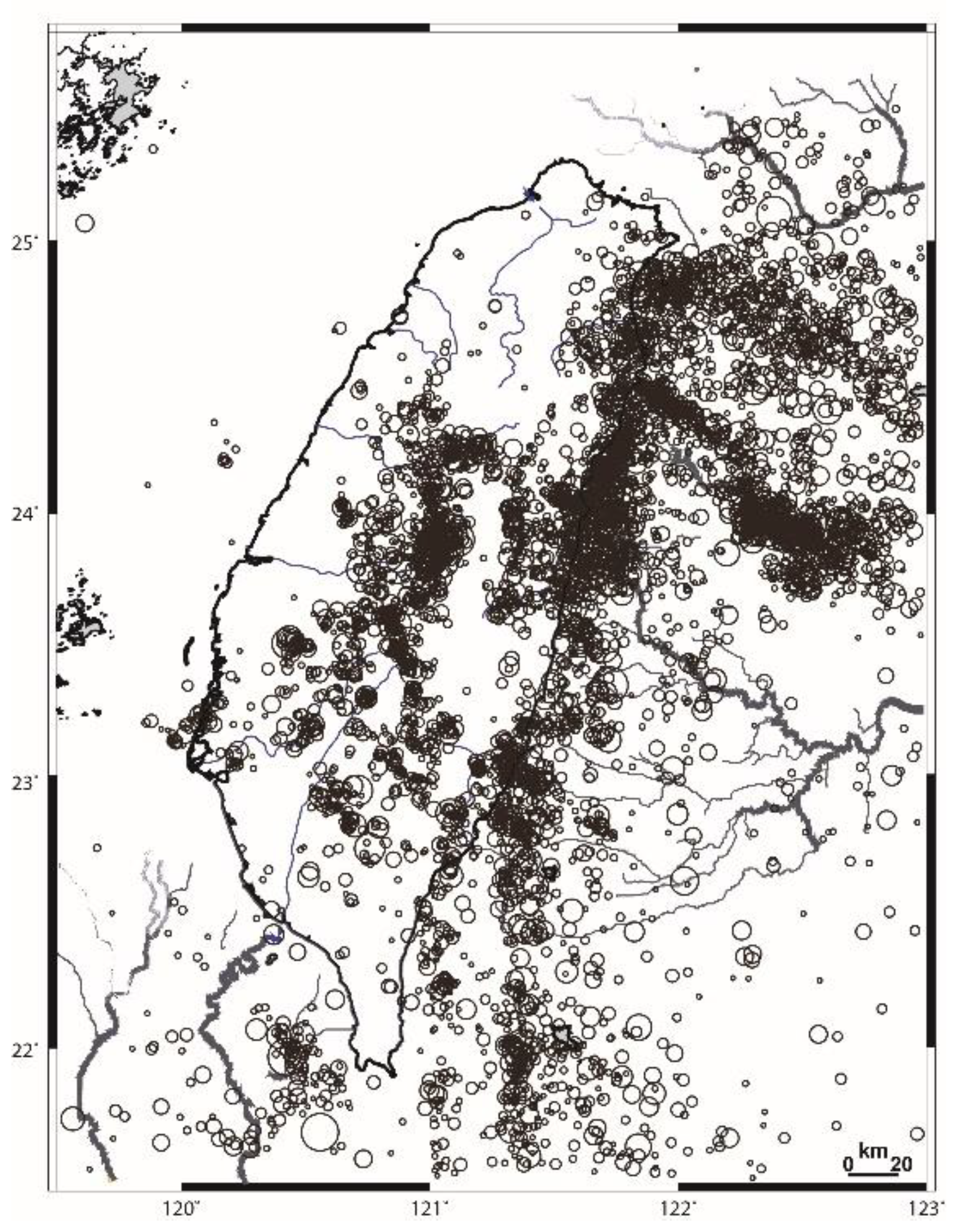

| Watershed | Drainage Area (km2) | Length (km) | Suspended Sediment Discharge (Mt/yr) |
|---|---|---|---|
| Fengshan | 208 | 250 | 1 |
| Taan | 633 | 95.8 | 7 |
| Tachia | 417 | 124.2 | 1 |
| Choshui | 2989 | 186 | 54 |
| Pachang | 441 | 80.9 | 6 |
| Tsengwen | 1157 | 138.5 | 25 |
| Erhjen | 175 | 63.2 | 47 |
| Kaoping | 3257 | 171 | 49 |
| Peinan | 1584 | 84.4 | 88 |
| Hsiukuluan | 1539 | 81.2 | 22 |
| Hualien | 1506 | 57.3 | 31 |
| Hoping | 553 | 50.7 | 15 |
| Criterion | Penghu Canyon | Shoushan Canyon | Kaohsiung Canyon | Kaoping Canyon | Fangliao Canyon |
|---|---|---|---|---|---|
| Canyon type | Slope-confined canyon | Slope-confined canyon | 120 m depth contour canyon | 120 m depth contour canyon | Shore-connected canyon |
| Depth of the canyon head | 300 m | 560 m | 350 m | 50 m | 60 m |
| Morphology of canyon head | Branched head segment | Straight head segment | Straight head segment | Sinuous head segement | Straight head segment |
| Canyon head to shoreline | 28 km | 25 km | 10 km | 1 km | 7 km |
| Depth of the canyon head | 300 m | 560 m | 350 m | 50 m | 60 m |
| Criterion | Mienhua Canyon | North Mienhua Canyon |
|---|---|---|
| Canyon type | 120 m depth contour canyon | 120 m depth contour canyon |
| Morphology of canyon head | Branched head | Multi-heads |
| Canyon head to shoreline | 250 km | 280 km |
| Depth of the canyon head | 400 m | 350 m |
| Criterion | Hoping Canyon | Hualien Canyon | Chimei Canyon | North Sanxian Canyon | South Sanxian Canyon | Taitung Canyon |
|---|---|---|---|---|---|---|
| Canyon type | Shore-connected canyon | Shore-connected canyon | Shore-connected canyon | Shore-connected canyon | Shore-connected canyon | Shore-connected canyon |
| Morphology of canyon head | Straight head segment | Straight head segment | Straight head segment | Straight head segment | Straight head segment | Straight head segment |
| Canyon head to shoreline | 0 km | 0 km | 0 km | 4.5 km | 4 km | 0 km |
| Depth of the canyon head | 450 m | 280 m | 350 m | 160 m | 220 m | 150 m |
Publisher’s Note: MDPI stays neutral with regard to jurisdictional claims in published maps and institutional affiliations. |
© 2022 by the authors. Licensee MDPI, Basel, Switzerland. This article is an open access article distributed under the terms and conditions of the Creative Commons Attribution (CC BY) license (https://creativecommons.org/licenses/by/4.0/).
Share and Cite
Chiang, C.-S.; Yu, H.-S. Controls of Submarine Canyons Connected to Shore during the LGM Sea-Level Rise: Examples from Taiwan. J. Mar. Sci. Eng. 2022, 10, 494. https://doi.org/10.3390/jmse10040494
Chiang C-S, Yu H-S. Controls of Submarine Canyons Connected to Shore during the LGM Sea-Level Rise: Examples from Taiwan. Journal of Marine Science and Engineering. 2022; 10(4):494. https://doi.org/10.3390/jmse10040494
Chicago/Turabian StyleChiang, Cheng-Shing, and Ho-Shing Yu. 2022. "Controls of Submarine Canyons Connected to Shore during the LGM Sea-Level Rise: Examples from Taiwan" Journal of Marine Science and Engineering 10, no. 4: 494. https://doi.org/10.3390/jmse10040494
APA StyleChiang, C.-S., & Yu, H.-S. (2022). Controls of Submarine Canyons Connected to Shore during the LGM Sea-Level Rise: Examples from Taiwan. Journal of Marine Science and Engineering, 10(4), 494. https://doi.org/10.3390/jmse10040494






